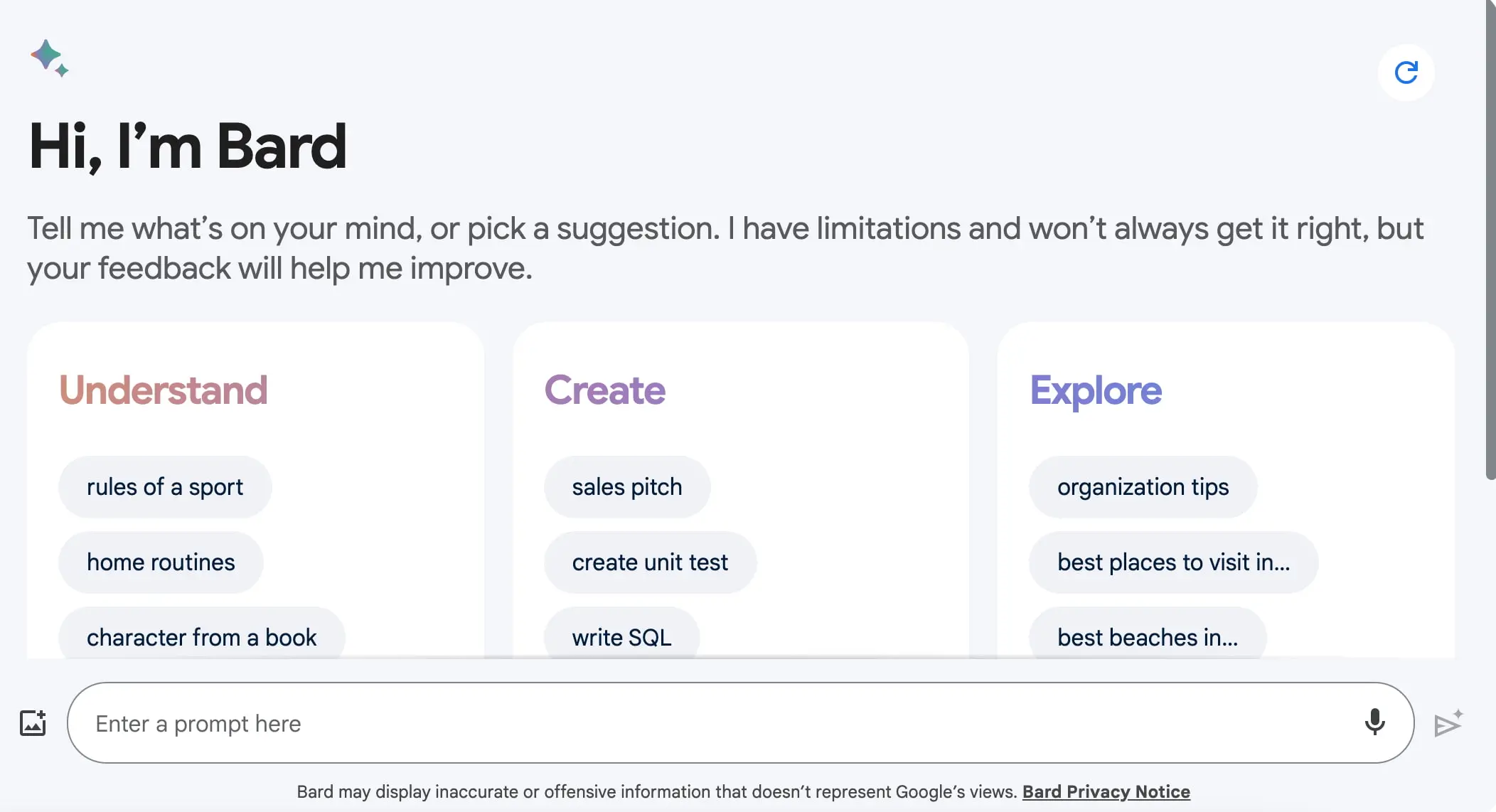Artificial intelligence (AI) tools have become integral to our daily lives. From virtual assistants to content generation, AI has revolutionized how we work, communicate, and create.
Following the release of OpenAI’s ground-breaking chatbot ChatGPT in November 2022, Google scrambled to develop its own impressive chatbot, Bard, released in March 2023.
Both chatbots are incredible in their own right, but which one should you use?
Whether you’re a content creator, a business owner, or simply someone curious about the capabilities of these AI marvels, this post is here to help you make an informed decision.
In this article, we’ll explore the unique features, strengths, and weaknesses of Bard and ChatGPT— empowering you to determine which best suits your specific needs.
Use the menu below to click through to the individual sections:
- Bard vs ChatGPT: At a glance
- Bard vs ChatGPT: Pros and cons
- Bard vs ChatGPT: Which should I use?
- Closing thoughts
1. Bard vs ChatGPT at a glance
Before we dive deeper into comparing Bard vs ChatGPT, let’s start with a quick overview of the two chatbots.
ChatGPT: the conversational companion
ChatGPT, powered by OpenAI’s remarkable GPT 3.5 architecture, has emerged as a versatile conversational companion, revolutionizing how we interact with AI-powered chatbots. ChatGPT can offer observations on complex problems, engage in casual conversation, or even help spur creativity (with the right prompts).
With its impressive language capabilities, ChatGPT can provide insightful answers, imitate different writing styles, and hold engaging conversations across various topics.
It has found its home in customer support chatbots, virtual assistants, and any application where interactive and engaging text-based conversations are essential.
To master the basics, check out our step-by-step guide on how to use ChatGPT.
How does ChatGPT work?
ChatGPT, like other models based on the GPT (Generative Pre-trained Transformer) architecture, works through pre-training and fine-tuning on a massive amount of text data.
ChatGPT was initially trained on a large and diverse corpus of text from the internet, with an information cutoff point in 2021.
During this pre-training phase, the model learned grammar, vocabulary, and general knowledge to predict the next word in a sentence. It built a deep understanding of language by capturing patterns and relationships between words and phrases.
ChatGPT utilizes the Transformer architecture, a neural network architecture that excels at processing data sequences, making it well-suited for natural language understanding and generation tasks.
After pre-training, the model is fine-tuned for specific tasks to make it more useful and safe for real-world applications. Fine-tuning involves training the model on a more narrow dataset that is carefully generated with human reviewers following guidelines provided by OpenAI.
These reviewers review and rate model outputs for various inputs to help the model learn appropriate responses.
When you use ChatGPT, it takes your input text and processes it through its trained neural network. It responds by predicting the most likely next word or phrase based on the patterns it learned during pre-training and fine-tuning.
The model can generate text one word at a time, and this process continues until it decides to stop based on the context and a defined stopping criterion.
It’s important to note that both Bard and ChatGPT employ safety mechanisms to prevent harmful or inappropriate content. These mechanisms filter out or reject outputs that violate content guidelines.
However, they are imperfect, and there can be challenges in striking the right balance between safety and the model’s ability to generate creative and useful responses.
ChatGPT’s user interface
ChatGPT utilizes a “conversational” UI, which presents a stream of questions and answers as if you were chatting to a friend on a messaging app. This is opposed to a visual interface, which would present information in various graphics, icons, and other imagery.
Conversational UIs have existed for some time (you may remember the Microsoft Office assistant “Clippy”, launched in 1997), but the limitations of AI have meant that—up until now—conversational interfaces have led to underwhelming user experiences.
In ChatGPT’s case, with its strikingly human-like (and often witty) responses, the conversational UI works fantastically for inputting prompts.

Bard: the accurate wordsmith
Bard is an experimental, multilingual chatbot developed by Google and launched in the spring of 2023. Bard can assist with writing needs, math problems, and even coding.
Named after William Shakespeare (often called The Bard), Bard is pitched as a creative content generator, offering poetry, creative writing, and storytelling services.
Bard’s unique selling point, however, is its accuracy. Unlike ChatGPT, Bard draws live information from the internet, meaning it needs to fill in the gaps or “hallucinate” less than GPT models trained on old data.
How does Bard work?
Bard currently uses Google’s cutting-edge PaLM 2 language model. This is a bold move, as most popular AI chatbots today, such as ChatGPT and Bing Chat, rely on models from the GPT series.
PaLM 2 is significantly larger than OpenAI’s free architecture, boasting up to 340 billion parameters compared to GPT-3.5’s 175 billion. This impressive scale enables PaLM 2 to draw from masses during training.
PaLM’s two knowledge base contains information from millions of documents that it can reference during tasks. In contrast, ChatGPT relies solely on the patterns and examples from its training data.
Bard’s user interface
Like ChatGPT, Bard’s UI presents a vertical flow of questions and answers, together with a list of past conversations on the left-hand side.
As Bard is integrated with other Google apps, a few more buttons and icons surround the screen.
This familiar interface, combined with the distinct lack of ChatGPT’s subversive humor, leaves Bard feeling like a functional workplace tool rather than interacting with a magical being.

2. Pros and cons
Let’s weigh up the pros and cons of Bard vs ChatGPT.
Pros of ChatGPT
- ChatGPT shines in its ability to produce human-like responses in text-based conversations. It understands context, maintains coherence, and adapts to the tone of the conversation.
- ChatGPT is very funny and outperforms Bard in various language tests.
- Integrating ChatGPT into your projects is relatively straightforward, making it accessible for developers and businesses looking to enhance their applications with conversational AI.
- Anyone can create a ChatGPT account using any email address.
- ChatGPT can produce long responses, with a “regenerate” button for all answers.
- Basic access to ChatGPT is free.
Cons of ChatGPT
- ChatGPT is not “connected” to the internet and can only pull information from its training data, which ends around September 2021. This means ChatGPT has no knowledge of current events.
- ChatGPT is currently only available in English language format.
- Using ChatGPT’s powerful GPT 4 architecture requires a monthly subscription fee of $20.
- Like all AI models, ChatGPT is not infallible. It can “hallucinate” incorrect information or biased responses, especially if it has been trained on biased data.
- Keeping a ChatGPT-based system up-to-date and monitoring its responses for accuracy and appropriateness can require ongoing effort.
- While ChatGPT excels in generating coherent text, it may struggle to convey deep emotional understanding and empathy in responses.
ChatGPT is an invaluable tool for businesses and developers looking to incorporate natural language conversation capabilities into their applications.
Its versatility and ease of use make it a top choice for many, but users should be mindful of its limitations and invest in proper monitoring and fine-tuning to ensure the best results.
Pros of Bard
- Bard pulls information directly from the internet, meaning it can provide up-to-date information on current events.
- Bard’s reputation is built on factual accuracy.
- Using Bard is entirely free.
- Bard is available in over 40 languages, including Hebrew, Swahili, and Urdu.
- Bard outperforms ChatGPT in translation and math tasks.
- Bard is integrated with other Google apps.
Cons of Bard
- Bard’s answers feel more robotic and lack the witty, human dimension that has given ChatGPT such an impact.
- Bard underperforms alongside ChatGPT in various writing tasks, such as recreating sonnet forms and making creative arguments.
- Bard is still in the experimental phase and is, therefore, more prone to biases and stereotyping.
- Bard is very much a Google application and has limited integration with non-Google products.
3. Bard vs. ChatGPT: Which should I use?
Now that we’ve examined the strengths and weaknesses of Bard vs ChatGPT individually, it’s time to tackle the big question: which of these AI models should you use?
The answer depends on your specific needs, goals, and the nature of your project. Let’s break it down further to help you make an informed decision.
When to use Bard:
- Data Manipulation: PaLM 2 can extract valuable insights from documents, identify anomalies within data, and perform format conversions. Its error rate is lower than GPT-3.5 thanks to its ability to reference its knowledge during these tasks.
- Customer Support: Several companies are exploring using PaLM 2 to drive AI chatbots, virtual assistants, and helpdesk applications for effectively addressing customer inquiries.
- Software Development: Although PaLM 2 exhibits potential in auto-completing code snippets and rectifying syntax errors, it has yet to match GPT-3.5 in code generation due to disparities in their knowledge bases.
- Answering Questions: PaLM excels in answering factual queries by leveraging its extensive knowledge base. Its performance surpasses GPT-3.5 in question-answering tasks due to its well-informed responses.
- Summarization: PaLM 2’s wealth of knowledge empowers it to craft highly accurate summaries of texts and data compared to GPT-3.5. It excels at discerning critical information while filtering out extraneous details.
When to use ChatGPT:
- You need conversational AI: If your project involves chatbots, virtual assistants, or any application that requires interactive, natural-sounding conversations, ChatGPT is the go-to choice.
- Imitating writing styles: ChatGPT excels at re-wording text passages in any voice or tone.
- Code generation: GPT-3.5 has demonstrated its capacity to produce rudimentary code fragments and can be used for code autocompletion and rectifying syntax issues.
- Generating ideas: ChatGPT is capable of thinking outside the box and often provides surprising, funny, and strange responses to questions.
- You Require Real-Time Responses: ChatGPT’s conversational prowess can provide an edge when timely responses and user engagement are essential.
Consider a hybrid approach
In some cases, the best solution might involve a hybrid approach that combines the strengths of both Bard and ChatGPT. For instance, you could use Bard to research up-to-date information and then integrate ChatGPT for natural language interactions or to create engaging context-aware responses.
Ultimately, the choice between Bard and ChatGPT hinges on your project’s specific requirements and objectives. Both AI models have unique strengths, and selecting the right one or a combination can significantly enhance your creative or professional endeavors.
To make the best choice, assess your project’s goals, user expectations, and the type of content you need, and let that guide your decision-making process.
4. Closing thoughts
In the ever-evolving landscape of AI-powered text generation, the choice between Bard and ChatGPT represents a significant decision for creators, businesses, and developers alike. Each AI model brings its own set of strengths and capabilities to the table, and the ideal choice depends on your specific needs and objectives.
If your business relies on up-to-date facts or is already embedded in the world of Google, then Bard may be the way to go. Conversely, if your project revolves around interactive, human conversations with context-aware responses, ChatGPT emerges as the frontrunner.
Remember that there’s no one-size-fits-all answer; in some cases, a hybrid approach incorporating both AI models might yield the best results. The key lies in understanding your project’s unique demands and leveraging the strengths of Bard and ChatGPT to meet those needs effectively.
To dive deeper into the subject, check out this article on ChatGPT and this guide to LLMs.
If you found this article useful, you might also like these:
